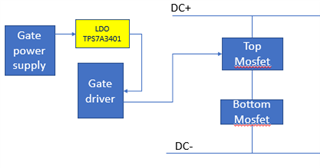Hi,
We are using TPS7A3401DGNR in our design for providing the negative supply to the gate driver IC.
Attached the schematic reference of the LDO

Regards
Smitha M S
The maximum temperature as per the calculation is around 100°C, considering the following specifications
- Input voltage = -11V
- Load current (continuous) = 85mA
- Output voltage = -4.8V
- Rthja = 63.4 K/W
But with the actual measurement the temperature is going beyond 100°C with increasing the DC bus voltage (>650V)
Could you please confirm whether the Rthja value provided in the datasheet is with bare footprint or with some copper area.
Also please suggest if there are any other recommendation or modification with respect to existing design is required



